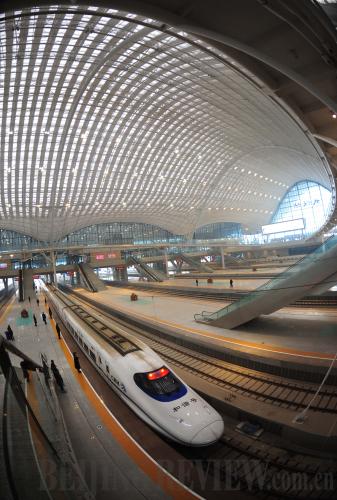|
 |
|
SUPER SLEEK: Fast rail services to soon cover China (XINHUA) |
The total investment for the World Cup in South Africa is estimated to be $4.5 billion – the largest amount ever in the event's history. Multiply this figure by 163, and you'll get the amount that China is going to spend on its railway network construction by 2020.
According to the Long-Term Railway Network Plan (LRNP) published by the Ministry of Railways (MOR), the Chinese Government will inject 5 trillion yuan ($732 million) within the next 11 years for nationwide railway network construction. The plan claims that by 2012, 36 passenger-dedicated rail lines, totaling 13,000 km, will be able to connect almost all major cities in China. And by 2020, the total length of high-speed rail lines with capacity for speeds of 200 km/h and above will be 18,000 km, representing more than half the world's total high-speed lines.
"By 2012, traveling by train will be as convenient as taking the bus [in China] and basically everyone will be able to go almost anywhere they want to go," Huang Qiang, Chief Expert of China Academy of Railway Science, told the Orient Outlook magazine.
On August 1, 2008, the Chinese people took a big step toward this dream. A high-speed rail line connecting Beijing and Tianjin, with a maximum operating speed of 350 km/h, was opened for use. Passengers now need no more than half an hour to finish the 120 km-long trip and enjoying the convenience of a guarenteed 15-minute departure interval during peak traveling times.
Sixteen months after this success, another line with an operating speed of 341 km/h was put into service as well: starting from Wuhan (central China), passengers can finish a trip of 1,069 km and arrive in Guangzhou (south China) in three hours. That is seven hours shorter than in the past.
However, the allure of the high-speed railway goes far beyond the thrill of speed.
Profitable plan
Sun Zhang, one of the first members participating in the feasibility study on construction of China's high-speed rail network and professor at the Institute of Urban Mass Transit Railway of Tongji University, believes that the high-speed railway layout will greatly enhance China's transport capacity and promote freight transportation, population movement and economic vitality in the world's fastest growing economy.
According to Sun, the first Shinkansen in Japan has an annual transportation capacity of 170 million passengers. That number is three and four times higher respectively than that of flights and highways covering the same route, and only 20 percent and 40 percent of their transport costs.
The MOR considers electrified high-speed rail networks to be a high performer in terms of "economical use of land and existing resources and environmental protection," making it perfectly suited to the Chinese Government's energy strategy.
Sun said that, according to current estimates, if the unit of energy consumption required per passenger on high-speed rail stands for 1, then a car is 5.3 and a plane is 5.6. On top of that, the land occupation of a two-way four-lane highway is 60 percent greater than a double-track high-speed railway. The land requirements of a large airport are equal to a 1,000 km-long double-track, high-speed railway.
Speed leader
Although some foreign competitors claim to have experimented with high-speed trains at 500 km/h, the Beijing-Tianjin high-speed rail line remains the world's fastest in real operation.
Experts point out that before China started mass construction of its high-speed railway network, little knowledge had been collected regarding the large-scale implementation of high-speed railways in other countries around the world. As a result, its experience of using high-speed rail technology over a long distance and in vast territory is actually what many overseas projects need, especially since China has developed its own standard system in the field of track design and construction.
"Compared with Germany and Japan, who are the world's leading high-speed railway builders, China's technologies show three advantages," explained an official from MOR. First, China can export a package of technologies ranging from construction works, power supply, communication and signals to vehicle manufacturing, which is rare in other countries, he said. Second, China is able to help renovate old lines while constructing new ones. Third, the costs of Chinese-built high-speed rail lines are 20 percent lower than those of its competitors.
At present, a number of countries, including the United States, Russia, India, Saudi Arabia and Venezuela, have already started, or shown interest in, cooperating with China on high-speed rail projects.
Capacity of urban transport modes per meter of infrastructure width
(Unit: persons per hour)
Passenger car: 200
Bus: 1,500
Bus lane (separate): 5,200
Rail: 9,000
Source: Union internationale des chemins de fer |